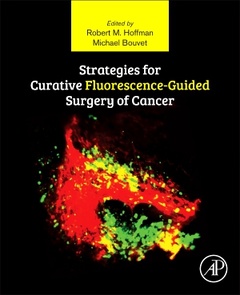Strategies for Curative Fluorescence-Guided Surgery of Cancer
Coordonnateurs : Hoffman Robert, Bouvet Michael

Strategies for Curative Fluorescence-Guided Surgery of Cancer is the first book to discuss how fluorescence-guided surgery can be successfully used during surgeries with several tumor types. FGS is one of the most exciting emerging modalities of surgery, especially cancer surgery, as it potentially allows the surgeon to visualize the actual margin of the tumor, thus greatly increasing the possibility of curative resection. The book discusses the applicability of FGS for several types of cancer, such as pancreatic cancer, liver metastasis, soft-tissue sarcoma, glioma, melanoma, and breast and lung cancer.
This book is a valuable resource for cancer surgeons, cancer researchers and members of several other areas in the biomedical field who are interested in understanding this powerful technique.
1. Cancer surgery: the major problems and impediments for cure2. FGS: the major principles3. Principles of antibody labelling of tumors for FGS4. Principles of labelling of tumors with genetic reporters for FGS5. Principles of curative FGS of cancer6. Principles of curative FGS of pancreatic cancer7. Principles of curative FGS of liver metastasis8. Principles of curative FGS of soft-tissue sarcoma9. Principles of curative FGS of glioma10. Principles of curative FGS of melanoma11. Principles of curative FGS of triple-negative breast cancer12. Principles of curative FGS of lung cancer13. Color-coded labeling of cancer and stroma for curative FGS14. Future of curative FGS15. Instrumentation for FGS
cancer surgeons; cancer researchers; general surgeons; surgical residents.
- Presents an overview of fluorescence-guided surgery
- Explains general strategies for curative fluorescence-guided surgery and their applicability for each major tumor type
- Discusses the current and future achievements of FGS as a precise technique for cancer surgeries
Date de parution : 05-2020
Ouvrage de 294 p.
19x23.3 cm
Thème de Strategies for Curative Fluorescence-Guided Surgery of... :
Mots-clés :
?Acquisition methods; Activatable probe; Anastomotic leak; Anatomical liver resection; Anti-CEA antibody; Antibody; BLS; Biliary imaging; Bright-light surgery; CRC; Colon cancer; Color-coded cancer; Colorectal cancer; Colorectal liver metastasis; Confocal laser endomicroscopy (CLE); Disease-free survival; Early gastric cancer; Endoscopic ultrasound-guided needle-based confocal laser endomicroscopy (EUS-nCLE); Esophageal cancer; Esophagectomy; FGS; Fluorescence; Fluorescence angiography; Fluorescence imaging; Fluorescence imaging basics; Fluorescence intensity; Fluorescence quantification; Fluorescence-guided surgery; Gastrectomy; Gastric cancer; Gastric conduit; Green fluorescent protein; Hepatocellular carcinoma; ICG; ICG fluorescence; Imaging systems; Indocyanine green; Intraductal papillary mucinous neoplasm (IPMN); Intraoperative cholangiography; Laparoscopic cholecystectomy; Laparoscopic liver resection; Liver metastasis; Liver resection; Liver segmentation; Lymph node mapping; Lymphadenectomy; Metastasis; Middle hepatic vein; Minimally invasive surgery; Molecular imaging; Monoclonal antibodies; Mucinous cystic neoplasm (MCN); Navigation surgery; Near-infrared fluorescence cholangiography; Near-infrared imaging; Nude mice; Orthotopic; Osteosarcoma; Overall survival; PDOX; Pancreatic cancer; Pancreatic cystic lesions (PCLs); Parathyroid gland; Perfusion assessment; Recurrence-free surgery; Relapse-free survival; Sentinel lymph node; Sentinel node navigation surgery; Serous cystadenoma (SCA); Standardization; Stromal cells; Tailor-made function-preserving surgery; Telomerase-dependent; Thyroid surgery; Tumor; Tumor-specific antibodies; Tumors



